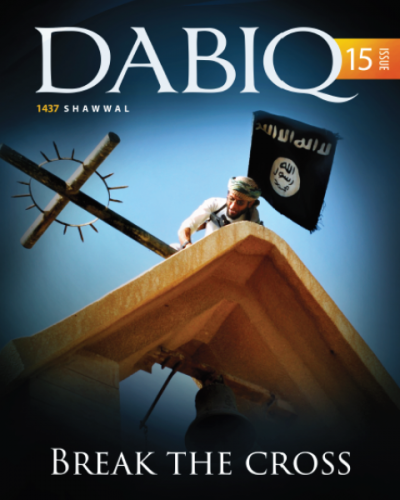‘Breaking the cross’: Pathetic ISIS 'theologians' get wires crossed
by - 3rd August 2016

MISAPPREHENSION of Christian doctrine once again provides the excuse for Islamic State war-mongering.
The latest issue of its propaganda magazine Dabiq focuses on the crucifixion of Jesus and the Trinity, although Judaism, secularism, atheism, and feminism also get a drubbing.
The issue invites Christians in particular, and other non-Muslims in general, to abandon their beliefs and adopt Islam – an invitation accompanied by violent threats against those who refuse.
The introduction exults in recent attacks in Orlando, Nice, Germany and Normandy, adding: ‘[W]e take this occasion of multiple massacres inflicted upon their citizens and interests to call them once again to the religion of pure monotheism, truth, mercy, justice, and the sword. ‘
As in previous issues of Dabiq, the magazine opens with the declaration of the group’s founder, Abu Mus’ab az-Zarqawi, that the jihad will not end ‘until it burns the Crusader armies in Dabiq’ – a reference to the site of the great end-times battle in an otherwise obscure apocalyptic hadith [alleged saying of Muhammad].
The back cover of the magazine closes with another hadith. ‘By the One in whose Hand is my soul, very soon shall the Son of Maryam descend in your midst, being an equitable judge. He shall break the cross, kill the swine, and put aside the jizyah.’
The Son of Maryam is Jesus, known to Islam as the prophet Isa, whose second coming is predicted by ISIS to occur at the Umayyad mosque in Damascus.
The jizyah is the tax that ‘people of the book’ must pay to practise their religions under Islamic rule.
This is the standard end-times hadith about Isa coming to ‘break the cross’ – picking up presumably a reference in the Book of Revelation to Christ the Prince of Peace returning to destroy the power of evil. It is not one that deals with the prophesied battle at Dabiq.
While Isa is supposed to come to put an end to evil, the magazine merely shows ISIS men energetically vandalizing Christian buildings instead.
The Clarion Project, a counter-Islamist group which monitors Islamist teachings, summarizes the magazine’s contents:
‘The main feature "Breaking the Cross" is an extended rebuttal of Christian and Jewish theology which sets forth the arguments to believe in Islam. The bulk of the theological arguments are fairly standard lines of attack about the alleged ‘absurdity’ of the Trinity and the alleged corruption of scripture by Jews and Christians such as many imams might argue.
‘The leap from mainstream Islamic monotheism to the violent slaughter of anyone who disagrees with ISIS is not explained clearly.’
Crucifixion
 Sura 4 verses 157-8 of the Qur’an state that while the Jews claim to have killed Jesus son of Mary, ‘they did not slay him; nor did they crucify him, but it appeared so unto them . . . But God raised him up unto Himself; and God is Mighty, Wise.’
Sura 4 verses 157-8 of the Qur’an state that while the Jews claim to have killed Jesus son of Mary, ‘they did not slay him; nor did they crucify him, but it appeared so unto them . . . But God raised him up unto Himself; and God is Mighty, Wise.’
Ibn Kathir in his thirteenth-century commentary on the Qur’an suggests that some of the disciples witnessed the ‘raising up’ or ascension, and were thus certain Jesus had not died, while others saw only the appearance of his death by crucifixion, hence the later Christian teaching that he ‘was crucified, dead, and buried.’
Traditions that Jesus was not in fact crucified, but that someone else was crucified in his place, can be found in Gnostic scriptures, regarded as heretical, and it is possible that Muhammad encountered them.
The Acts of John are an example, published by M.R. James in the Apocryphal New Testament in 1924. It claims that John was inspired by Christ to flee the scene of the crucifixion and go up the Mount of Olives, where Christ showed himself to him ‘not having any shape, but only a voice: and a voice not such as was familiar to us, but one sweet and kind and truly of God.’
There Christ instructs him, ‘John, unto the multitude below in Jerusalem I am being crucified and pierced with lances and reeds, and gall and vinegar is given me to drink. But unto thee I speak, and what I speak hear thou. I put it into thy mind to come up into this mountain, that thou mightest hear those things which it behoveth a disciple to learn from his teacher and a man from his God.’
That such traditions existed among some early Gnostic followers of Christ is clear. Orthodox Christian teaching, however, considers the crucifixion to be a historical reality.
John Dominic Crossan, a Catholic scholar noted for his independent views, sums up the historical evidence for Jesus’ crucifixion thus: ‘That he was crucified is as sure as anything historical can ever be, since both Josephus and Tacitus … agree with the Christian accounts on at least that basic fact.’
OXYGEN OF PUBLICITY
Why have we given yet more attention to the evil folly of ISIS? Analyst JM Berger, who almost single-handedly got Twitter to shut down a multitude of ISIS accounts, would say it is important to be accurately informed as to motivation. We also believe the French got it right when they cut off the ‘oxygen of publicity’by refusing to post the names and photos of terrorists. We believe it is the ‘fame’ angle that needs to be starved, not analytic information itself. Dabiq magazine runs for eighty pages.
